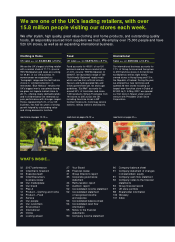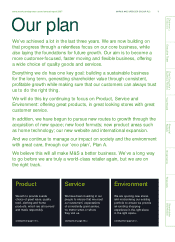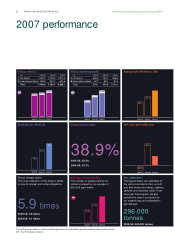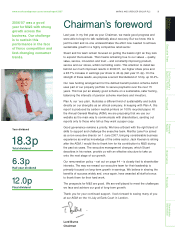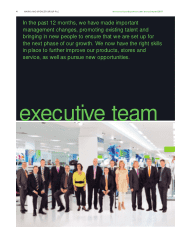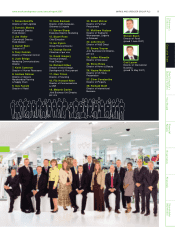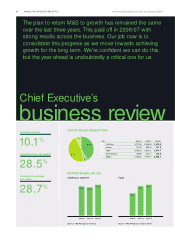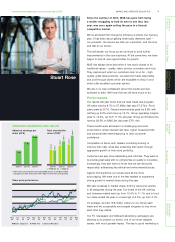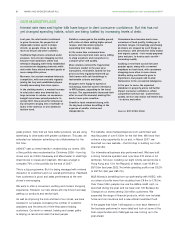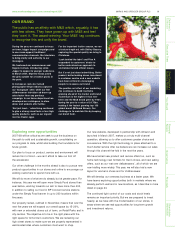Marks and Spencer 2007 Annual Report Download - page 10
Download and view the complete annual report
Please find page 10 of the 2007 Marks and Spencer annual report below. You can navigate through the pages in the report by either clicking on the pages listed below, or by using the keyword search tool below to find specific information within the annual report.
great product. Now that we have better products, we are using
advertising to drive sales with greater confidence. This year, we
extended our television advertising into childrenswear for the
first time.
2006/07 saw us invest heavily in modernising our stores. 35%
of the portfolio was modernised by Christmas 2006 – from big
stores such as Cribbs Causeway and Manchester to small high
street stores in Crewe and Clapham. We have a target to
complete 70% of the portfolio by the end of 2007.
This is a big programme. But it is being managed with minimal
disruption to customers and our overall performance. Feedback
from customers is good and sales performance at the new
stores is encouraging.
We want to offer a convenient, exciting and modern shopping
experience. However, our new stores will only thrive if we keep
getting our products and service right.
As well as improving the look and feel of our stores, we have
invested in our people, increasing the number of customer
assistants and the amount of time they spend helping
customers. Our work on reward, training and career paths
is helping us recruit and retain the best people.
The website, www.marksandspencer.com, performed well,
reaching sales of over £100m for the first time. We know that
online is a big opportunity for us and, in March 2007, we
launched our new website – the first step in building our multi-
channel offer.
Our international business also performed well. We have built
a strong franchise operation and now have 219 stores in 34
territories. Turnover, including our eight wholly-owned stores in
Hong Kong and 13 in the Republic of Ireland, rose 16.8% to
£610.6m (last year £522.7m) while operating profits rose 33.2%
to £87.5m (last year £65.7m).
M&S Money is benefiting from our partnership with HSBC, with
our share of profits more than doubling from £9.6m to £19.5m.
Over three million people now use the &More credit card, re-
launched during the year, and we have over 100 Bureaux de
Change at our stores serving 3.8 million customers. We
expanded the range of financial products, which now includes
home and car insurance and a new ethical investment fund.
In the pages that follow I will expand on how each element of
the business performed in more detail and look at some of the
main opportunities and challenges we see coming up in the
year ahead.
8MARKS AND SPENCER GROUP PLC www.marksandspencer.com/annualreport2007
OUR MARKETPLACE
Interest rate rises and higher bills have begun to dent consumer confidence. But this has not
yet changed spending habits, which are being fuelled by increasing levels of debt.
Last year, the retail market continued
to grow. However, the proportion of
disposable income spent in shops
shrank, as people chose to spend
more on leisure and other activities.
Traditional high streets remained under
pressure. Out-of-town shopping centres
became more dominant; online and
television shopping were firmly established
as mainstream shopping channels; while
mail order firms offered branded goods at
more competitive prices.
Moreover, the market remained intensely
competitive, with new entrants regularly
joining the fray and established players
steadily increasing their store space.
In the clothing market, a modest increase
in total sales value was dwarfed by a
large increase in volume, as consumers
bought more lower-priced products. In
spring 2007, this was further influenced
by consumers buying into a multitude of
looks in the absence of one dominant
fashion trend.
Retailers converged in the middle ground,
with value retailers adding higher-priced
ranges, and mid-market players
expanding their value ranges.
At the same time customers have
become less loyal and more savvy, willing
to shop anywhere and everywhere to
compare price and quality.
More retailers entered the fragmented
homeware market in the past year.
Consumers, meanwhile, looked for low
prices as they regularly freshened up
their homes with soft furnishings in
fashionable colours and styles.
Shoppers were happy to spend on
technology, from flat-screen televisions
to MP3 players, upgrading to the latest
version. The supermarkets increased their
offer to meet this demand, making this
market more price sensitive.
Growth in food remained strong, with
the big food retailers benefiting at the
expense of smaller chains and
independents.
Consumers have become much more
conscious of food quality, trading up to
premium ranges. Increasingly, purchasing
decisions are swayed by such things as
provenance, with demand for fairly traded
and organic goods – from ready-prepared
jams and pies, to basics such as milk –
increasing rapidly.
Cooking a meal from scratch became
popular again, along with a renewed
emphasis on fresh food, with consumers
shopping more often in more stores.
Healthy eating continued to grow in
importance, but people still treated
themselves to the occasional indulgence.
In the year to come, the expected
slowdown in property prices will further
impact consumer confidence, whilst
competition will increase. Convenience,
quality, service and choice will remain key
– in stores and online.
Sources: BRC/KPMG; Mintel


